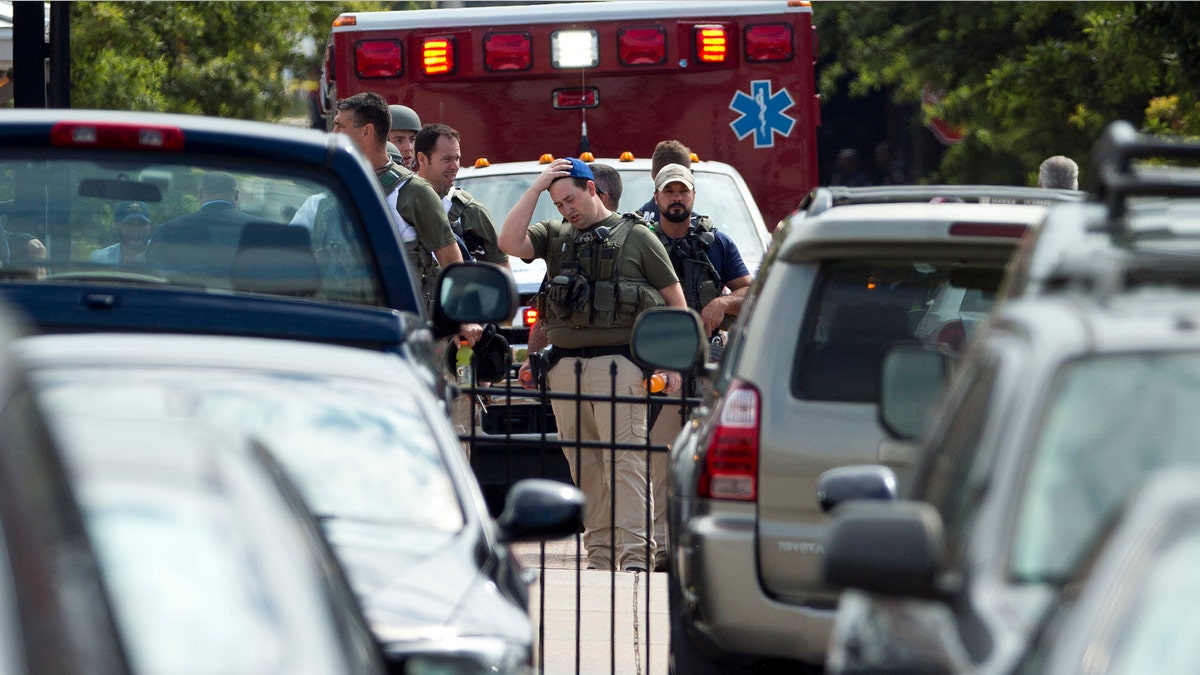
September 16, 2013: Heavily armed U.S. marshals walk from the Washington Navy Yard after a shooting by gunman Aaron Alexis. (Reuters)
WASHINGTON – Lawmakers are calling on federal investigators to track down why cops, firefighters and medics -- for the third time in the last year -- suffered from faulty equipment and busted communication lines during a crisis.
Reports have surfaced that emergency workers grappled with serious radio problems during the Washington Navy Yard mass shooting. It has once again drawn attention to a glaring communication gap some say has handicapped field crews for more than a decade.
Gregory Russell, president of IAFF Local F121, which represents 250 federal civilian firefighters in the Washington area, said that the radios used by responders during the D.C. shooting were not able to transmit clearly through building walls and that during the D.C. shooting, a fire chief had to use a “runner” to go outside a safe building to transmit radio commands.
That’s not sitting well with Reps. Henry Waxman, D-Calif., and Anna Eshoo, D-Calif., who sent a Sept. 23-dated letter to Lawrence Strickling, assistant Commerce secretary for communication and information, and Federal Communications Commission Acting Chairwoman Mignon Clyburn looking for answers.
“If these reports are accurate, this will not be the first time communications difficulties impaired first responders during an emergency,” the letter stated. “Unfortunately, there have been numerous communication system failures during recent natural disasters and national emergencies, most notably the terrorist attacks on September 11, 2001.”
The communication clog at the Navy Yard seems to be the result of a series of relatively basic fails – like inadequate indoor coverage, interference caused by fire alarms and the batteries going bad in responder radios – all of which “contributed to the chaos and delay in emergency response to the massacre,” Russell said.
Complaints of faulty equipment and congested airwaves weighing down emergency efforts are all too common and have been brought up regularly by those tasked with keeping the public safe.
During the Boston Marathon bombings that killed three and injured more than 200 earlier this year, law enforcement officials were able to use upgrades to communication technology put in place following the 9/11 terrorist attacks. However, problems started stacking up after first responders tried to share the data they had with one another -- including videos of the suspects.
"Significant problems really arose ... with that essential delivery of big data packages, particularly the videos that proved to be so significant and important in the resolution of this event," Suzanne Spaulding, deputy undersecretary of the Department of Homeland Security, said at an April 23 meeting.
During Hurricane Sandy, cell towers up and down the East Coast became overcrowded, often ping-ponging responders from frequencies that allowed them to communicate with one another. Emergency personnel from different agencies were unable to communicate with one another and therefore unable to share updates and other information in real time.
The sting from Sandy led to the Federal Communications Commission holding regional roundtables to flesh out ways to close communication gaps. From those meetings came the creation of The First Responder Network Authority – or, FirstNet.
FirstNet operates as an independent entity within the National Telecommunications and Information Administration, which is part of the Department of Commerce.
It is funded by the Middle Class Tax Relief and Job Creation Act of 2012, and its goal is to provide emergency responders with the first high-speed, nationwide network dedicated to public safety, according to the government.
Under the Act, $7 billion was carved out for the program. An additional $135 million in grants was approved to help states and localities synch their emergency plans to a national digital system.
According to its website, FirstNet is currently operating in 56 U.S. states and territories, 3,252 counties and 566 federally recognized tribal areas.
During an April 23 FirstNet board meeting in Washington, Chairman Sam Ginn claimed “Congress got it right” by creating a unified emergency alert system that would loop in communities across the country.
Ginn and the other board members at the meeting also discussed how a public safety broadband network might have helped emergency efforts at the Boston Marathon bombing.
In August, FirstNet adopted a $194 million budget for fiscal year 2014 – which Waxman and Eshoo say should in part be used to dissect the reported communication breakdowns first responders encountered at the Washington military installation.
“It is imperative that we understand what happened to these communications systems and why,” the California lawmakers said. “And it is critical that the lessons of this latest tragedy be passed along to FirstNet, so it can design the future network to avoid such communication breakdowns.”
























